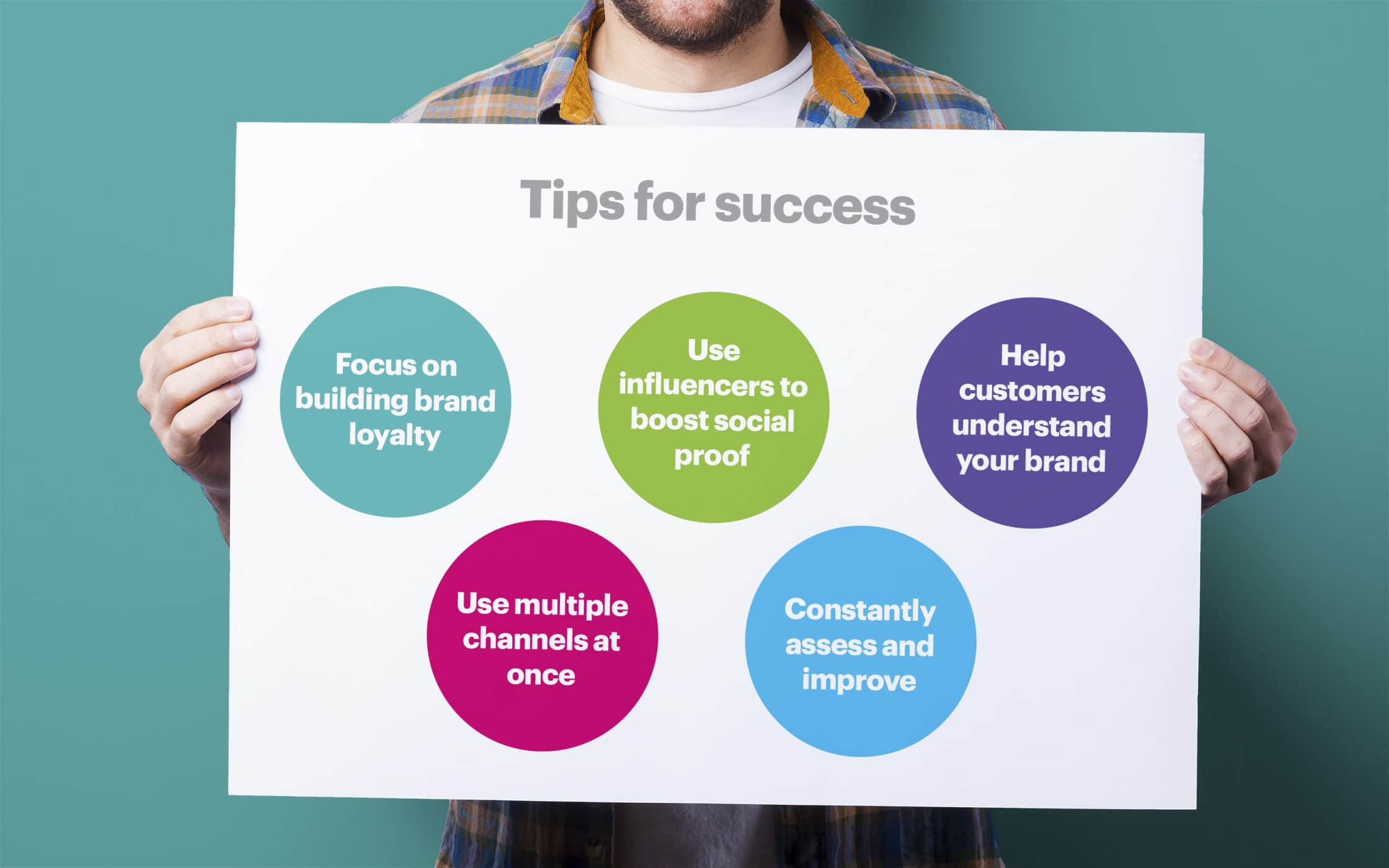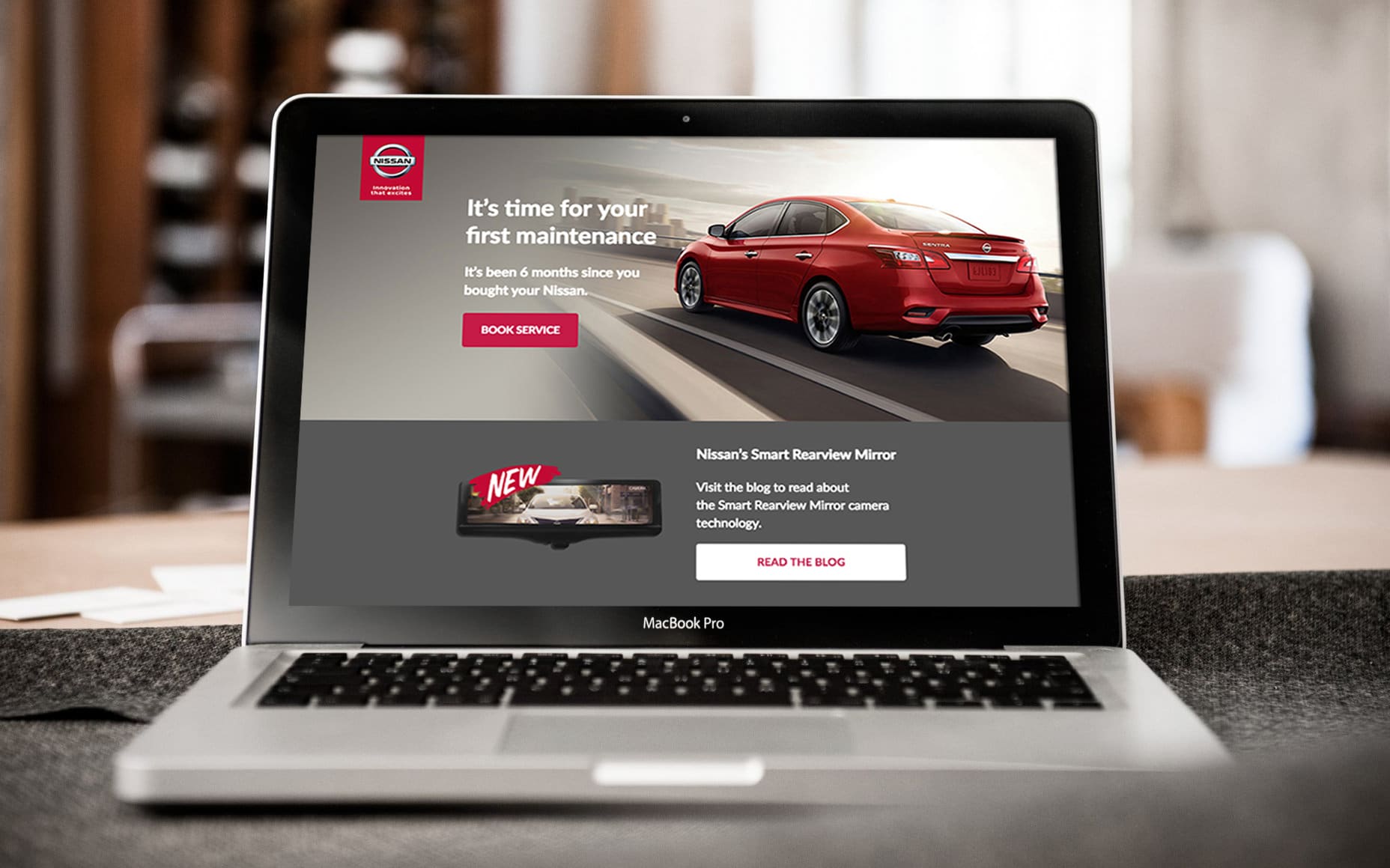The essential guide for B2C marketing: Indispensable ideas for cultivating more customers

Marketing is all about knowing who you’re speaking to.
If you want to make sure that you’re consistently selling products and services to a crowd of happy customers, then you need to make sure that you not only know your target market, but empathise with their pain points, understand their desires, and speak in their preferred language.
Before you can start translating your marketing messages into campaigns that resonate with your customers, you’ll need to ask yourself one essential question. Are you advertising to other brands, or are you selling to consumers?
“B2C Marketing”, or business to customer advertising, refers to the tactics that companies use to promote their services and products to the public. Unlike B2B (business to business), B2C marketing strategies often rely on a firm’s ability to capitalise on the value of the brand, evoke emotional responses, and generate social proof.
B2C companies understand that their customers are more likely to make impulse decisions, can be swayed by various factors, and require trust to establish loyalty. However, it’s worth noting that not all B2C prospects respond to the same marketing methods. If you want to make sure that you’re making the right kind of mark on your industry, then you need to start by creating your very own B2C marketing definition.

What is B2C marketing: Separating B2B and B2C marketing
In this guide, you’ll learn which B2C marketing strategies are the most effective, and we’ll look at examples from successful organisations, and determine how you can craft your own B2C marketing plan. However, before we get to that point, let’s answer the most important question: “What is B2C marketing?”
As mentioned above, B2C marketing is any tactic a company uses to engage and sell to a consumer. However, to truly understand what the term “B2C” means, you need to know the difference between B2B and B2C marketing.
Believe it or not, there’s a distinct difference between a marketing plan tailored to a customer and one designed for another business. While you’re still marketing to people, either way, research shows that the difference between the two strains of advertising runs deeper than you might expect.
For instance, in B2B marketing, companies often work to streamline and simplify the buying process to save money and time. B2B purchases are often focused more on “logic” while consumer purchases are linked more closely to emotion.
Additionally, while consumers can make impulse purchases based on how they feel at any given moment, B2B consumers must be able to prove a return-on-investment for their purchase. This means that you’re less likely to make a sale based on fundamental design elements like colour or font presented at a point-of-sale.
Connecting to customers: The tiers of a B2C marketing strategy
As with most things in the branding world, there’s no ultimate guide to engaging your audience with a B2C marketing strategy. As new channels, preferences, and technologies continue to emerge, it makes sense that the B2C environment will continue to change.
However, it’s worth noting that many companies involved with B2C marketing will focus on three essential tiers when they’re choosing the right strategies for promotion.
Step 1: Make customers into ambassadors
Customers are more likely to make decisions based on emotion than businesses. However, that doesn’t mean that your prospects and clients don’t need a little help when it comes to trusting your brand. In a highly cynical world, today’s leads are looking for signs that they can trust your company before they make a purchase. This means that B2C marketing campaigns rely heavily on social proof.
There are various forms of social proof out there, including client videos, testimonials, and even “likes” on your social media pages. The first tier of many great B2C marketing strategies involves transforming current happy clients into ambassadors for your brand. These ambassadors can then help to convince new customers to purchase from you, instead of a competitor. You can transform a customer into an ambassador by:
- Using referral programmes to distribute rewards every time someone refers a friend.
- Asking for testimonials and reviews from happy clients.
- Displaying user-generated content on your website and social channels (for instance, pictures or videos of someone using your product/service)
Support from your existing customers speaks louder than any traditional marketing message when it comes to converting new customers.
Step 2: Spread awareness with regular content marketing
Whether you’re creating a B2C marketing plan or a B2B campaign, content should be at the heart of everything you do. Today, content marketing is the ultimate inbound method for attracting people to your company through interesting and relevant posts on your blog, video channel, or social media pages.
If you want to create both brand recognition and awareness for your B2C company, then you need to make sure that you’re constantly producing a stream of diverse content. Usually, the easiest way to start is with regular blog posts and articles that help to demonstrate your industry authority, inform customers, and improve your search engine ranking. After all, SEO still matters in the B2C marketing place.
Once your written content starts to grow, you can also think about implementing other media like podcasts, video blogs, and infographic design too.
Step 3: Use social media to establish relationships
Finally, the third phase of your B2C marketing plan should be to invest in social media so that you can connect with your customers and supplement your other advertising efforts. Social media marketing has quickly emerged as one of the most important online tactics for today’s brands, as it allows them to talk to their clients in a more human, fast-paced environment.
While a B2B prospect might want graphs and reports to demonstrate the importance of making a purchase to a C-level executive, a B2C client simply wants to feel a sense of affinity with the brand they buy from. While proof of value can still be important, your B2C customer is more likely to be swayed by your marketing messages if they know you share the same values as them.
Use your social media channels to harness the critical relationships that are so important to B2C marketing strategies.
The best B2C marketing strategies: How to form your B2C marketing plan
Now you know the basic tiers of B2C marketing strategies, it’s time to think about how you’re going to create your own customised plan. After all, the best way to connect with your audience is to create your own B2C marketing definition based on what you know about your clients and their preferences.
Most companies in the B2C marketing world will start by generating buyer personas that they can use to determine which content and marketing strategies their leads are most likely to respond to. For instance, if you want to sell products to a younger audience, then you might be better served by social media marketing and creative contests than direct mail and television advertisements.
B2C marketing strategies are in a constant state of evolution, particularly as new generations enter the marketplace. The gold rules to follow when you’re forming your own B2C marketing plan are:
1. Connect with every prospect on a human level
As we’ve mentioned a few times in this guide, B2C buyer decisions are made with emotion and feeling. This means that you need to establish real, valuable connections with your audience. Think of your customers like human beings – not just ATMs designed to fund your brand.
Whether you’re posting on social media or writing blog articles, make sure that you’re creating content that demonstrates your values, shows your authentic side, and helps your customer to understand what you’re all about.
2. Focus on experience first
B2B companies look for a result in the products or services they buy. For instance, a software company might purchase a tool that makes their own product more efficient. On the other hand, customers – particularly modern ones – are looking for experiences.
In a world where there are countless competing products in any niche, 8 in 10 consumers will pay more for a better customer experience. This means that brands need to find ways to excite and delight their clients on every level. For instance, this could include running social media contests, giving customers multiple ways to get in touch, or having a great returns policy.
3. Remember SEO
Importantly, many of today’s customers in the B2C marketing world will still be looking for brands to work with on the search engine result pages. The key to success is making sure that you show up wherever your clients might be looking for you.
Think about how your ideal customer might look for the answers to their problems. Are they likely to search a hashtag on social media, or ask Siri a question on their phones? Will they type phrases and questions into Google? Don’t overlook the value of being optimised in B2C marketing.

Refining your B2C marketing definition: Tips for success
Despite its complexity, marketing will always be an essential component for any business. With the right B2C marketing strategies, you can establish brand visibility, and effectively generate ongoing sales and profits.
B2C marketing is all about understanding customer needs and tailoring your online approach to suit those requirements. Here are just some of the ways that you can make the most of your B2C marketing plan with some careful preparation and focus.
1. Focus on building brand loyalty
Once you’ve taken some time to figure out who your prospects are and what they’re looking for from you, your focus should be on developing strong brand loyalty. The easiest way to do this is often with B2C marketing companies who can help you to figure out how to speak to your target audience. Often, developing loyalty means segmenting your audience so that you can offer each group the exact experience they’re looking for. You can also think about building VIP and loyalty campaigns for your most valuable customers.
2. Use influencers to boost social proof
We mentioned the value of social proof in B2C marketing above. Your customers want to know they can rely on you to deliver a great product or service, and one great way to convince them is with influencer marketing. With influencer marketing, you can use an industry leader or celebrity’s power in a specific niche to turbo-charge your campaigns. The great news? You don’t even need to use a high-profile celeb. Instead, a micro-influencer with a good following could be a great way to enhance both B2B and B2C marketing strategies.
3. Help customers understand your brand
As clients become pickier about who they do business with, it’s important for B2C marketing teams to be strategic about the way they promote brands. Today’s customers, especially in the millennial demographic, want to feel as though they’re working with brands that have a positive impact on the world. With that in mind, it might be worth working on your corporate responsibility efforts or sharing more information about your brand vision. Anything that helps your customer resonate with your company is valuable.
4. Use multiple channels at once
The more you learn about B2C marketing, the more you’ll discover that your customers can come to you through a selection of different avenues. While some will find you through your thought-leadership posts and guides, others will come to you through links on your social media channels or press releases. It’s a good idea to employ multiple channels to engage your customers and reach out to new clients. For instance, you could:
- Host in-person events.
- Have an email marketing campaign.
- Use newsletters.
- Write blogs and articles.
- Have a podcast.
- Share messages on social media.
5. Constantly assess and improve
Periodic assessment of your B2C marketing strategies is an excellent way to make sure that you’re on the right track when reaching out to your consumers. The parameters that you’ll need to measure will depend on the unique goals of your campaign, but just some of the metrics that most organisations track include:
- Sales volumes linked to content marketing campaigns.
- Return on investment for advertising strategies.
- Customer response and engagement.
- Brand awareness (shown in social media followers, website traffic etc).
- Competitor response.
B2C marketing examples: Ideas to inspire you
Now we come to the fun part of our B2C marketing guide, where we look at examples of great strategies launched by other successful companies in the past.
Remember, the key to B2C marketing is making sure that you connect with your customers in the most appropriate places, at the most lucrative times. Today’s consumers have multiple outlets all vying for their attention, and this excessive noise ensures that brands must go above and beyond to earn conversions.
Here are just some of the lessons you can learn from companies who have delivered fantastic B2C marketing examples in the past.
B2C marketing examples: Warby Parker – know your customers
Knowing and understanding your audience is critical to developing a great B2C marketing plan. You need to know your customer’s dislikes, their preferences, their expectations, and their desires. Knowing your typical client and the challenges that they’re looking to solve is the perfect way to drive conversions and revenue.

Warby Parker is a company that’s frequently shown how well it understands its customers with an exceptional approach to customer service. Not only does this business offer cheaper designer brands for clients who can’t afford to pay a fortune, but it knows its customers are busy, so it also allows them to try frames on at their homes then send back the ones they don’t like to save time.
B2C marketing examples: Walkers – get people engaged
Since B2C marketing strategies need to focus on giving customers great experiences to remember, it’s important for brands to constantly think up new ways to engage their clients. A great way to do this is with social media contests and giveaways that get people involved with whatever might be going on in your business.
For instance, Walkers frequently boosts engagement and generates awareness for their brand by running campaigns where customers can vote for their favourite crisp flavours. One of the more recent deliveries in their B2C marketing plan was the “Choose me or Lose Me” concept, where classic flavours were pitted against new globally-inspired tastes. Walkers used their campaign to give consumers a voice and show them that they respect their opinion, all while offering a fun and interesting experience.
B2C marketing examples: Nordstrom – remember to retarget
According to CRM experts, Salesforce, it takes between six and eight touches in a customer buying journey to create a viable lead. In other words, your B2C marketing strategies need to involve a solution that allows you to connect with your customers more than just once.

A retargeting strategy can be a great way to convince clients to come back to your website or product pages after they’ve been distracted and gone elsewhere. Remember, your customers are constantly being pulled away by social media messages, chat windows, and texts, so you need to get them back in your hands as quickly as you can. Nordstrom uses triggered emails and cookie-enabled retargeting campaigns to make it impossible for clients to ignore their abandoned carts for too long.
B2C marketing examples: Sephora – create ambassadors with membership programmes
Remember how we told you that you need brand ambassadors to make your B2C marketing strategies really work? Well, a great way to transform the average customer into someone who will advertise on behalf of your business is with a membership programme or VIP strategy.

Sephora has a powerful membership programme they call “Beauty Insider”. This scheme is a merit-based programme that separates consumers into different tiers, each with its own specific set of unique rewards. This B2C marketing solution is effective because it helps to ensure that Sephora has a trust-packed way to promote their products. The more ambassadors work to help the brand, the more rewards they get.
B2C marketing examples: Nissan – connect on other channels
While it’s important to show your thought leadership through regular blog posts, and demonstrate your personality on social media, there are countless other channels to think about for B2C marketing. For instance, reminder emails are one of the easiest ways to reconnect with your customers and nurture them towards future sales. Reminder messages can keep your brand top of mind, which helps to facilitate conversions and up-selling.

Some of the best examples of email marketing strategies in the marketplace today can be attributed to car companies. For example, in the below email from Nissan, you can see how the company carefully collected relevant customer data and organised that information into segments so that they could send extremely personalised content to each client. Nissan also uses effective automation strategies to trigger reminders to customers about upcoming service needs, maintenance appointments and more. All this leads to an enhanced experience and a better customer relationship.

Adjusting your B2C marketing in a competitive world
Exceptional B2C marketing strategies have never been easy to define. However, we’re entering an era wherein connections with consumers are harder to establish than ever before. Today’s clients are empowered, savvy, and often unpredictable. The good news is that if you know how to understand them and tailor your marketing efforts accordingly, you could quickly and effectively boost your sales.
As technology and trends in the marketing world continues to evolve, so too will the B2C methods modern brands use. The good news is that we’re constantly discovering new ways for companies to automate, personalise, and enhance their B2C sales strategy.
The most important thing to know about B2C marketing is that it’s all about building real, authentic connections with your customers. Clients will pay more for a better experience, and many are driven by emotion, social proof, and feelings of affinity with the right business.
Now that the traditional method of mass-marketing has become outdated, it’s important to make sure that you’re connecting with each customer on a more personalised level. Whether you follow the steps above and attempt to implement a B2C marketing plan on your own, or you access the help of B2C marketing companies, the connections you make with your audience could make or break your business.
How do you connect with your B2C audience? Let us know in the comments below or reach out to Fabrik today for help designing your own B2C marketing plan.
If you enjoyed this article, you might enjoy these too:
— Your mission if you accept it: Brand aims and objectives
— Marketing techniques for non-conventional thinkers











